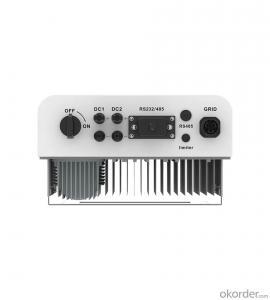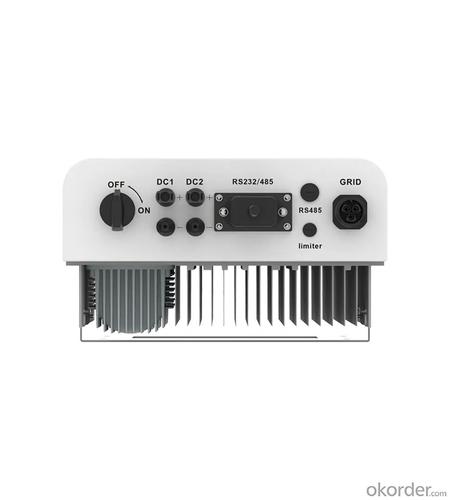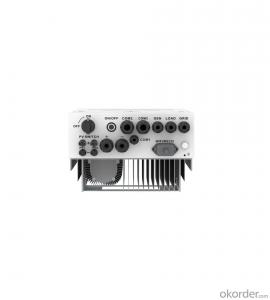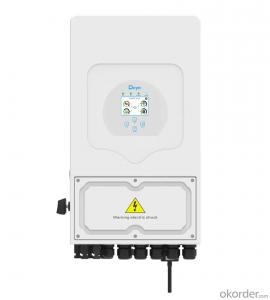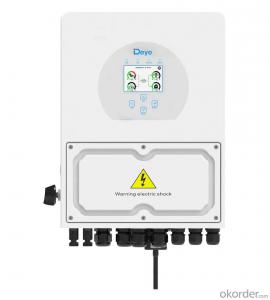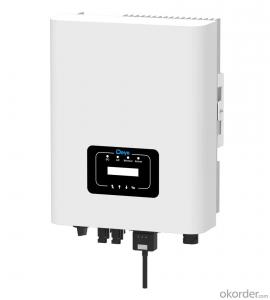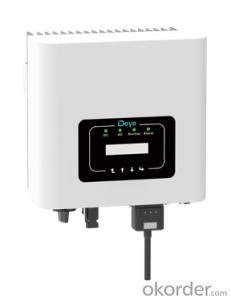Portable Solar Inverter - Sun-3.6/4/4.6/5/6k-g | 3.6-6kW | Single Phase | 2 MPPT
- Loading Port:
- Ningbo
- Payment Terms:
- TT OR LC
- Min Order Qty:
- 100 pc
- Supply Capability:
- 5000 pc/month
OKorder Service Pledge
Quality Product, Order Online Tracking, Timely Delivery
OKorder Financial Service
Credit Rating, Credit Services, Credit Purchasing
You Might Also Like
Specification
Output Power:
3.6kw-6kw
Inveter Efficiency:
97.1%-97.3%
Output Voltage(V):
220
Input Voltage(V):
550
Output Current(A):
15.7-26.1
Output Frequency:
50/60Hz
| Model | SUN-3.6K-G | SUN-4K-G | SUN-4.6K-G | SUN-5K-G | SUN-6K-G |
| Input Side | |||||
| Max. DC Input Power (kW) | 4.7 | 5.2 | 5.98 | 6.5 | 7.8 |
| Max. DC Input Voltage (V) | 550 | ||||
| Start-up DC Input Voltage (V) | 80 | ||||
| MPPT Operating Range (V) | 70~500 | ||||
| Max. DC Input Current (A) | 13+13 | ||||
| Max. Short Circuit Current (A) | 19.5+19.5 | ||||
| Number of MPPT / Strings per MPPT | 2/1 | ||||
| Output Side | |||||
| Rated Output Power (kW) | 3.6 | 4 | 4.6 | 5 | 6 |
| Max. Active Power (kW) | 3.96 | 4.4 | 5.06 | 5.5 | 6.6 |
| Nominal Output Voltage / Range (V) | L/N/PE 220V/0.85Un-1.1Un, 230V/0.85Un-1.1Un (Optional) | ||||
| Rated Grid Frequency (Hz) | 50 / 60 (Optional) | ||||
| Operating Phase | Single phase | ||||
| Rated AC Grid Output Current (A) | 15.7 | 17.4 | 20 | 21.7 | 26.1 |
| Max. AC Output Current (A) | 17.2 | 19.1 | 22 | 23.9 | 28.7 |
| Output Power Factor | 0.8 leading to 0.8 lagging | ||||
| Grid Current THD | <3% | ||||
| DC Injection Current (mA) | <0.5% | ||||
| Grid Frequency Range | 47~52 or 57~62 (Optional) | ||||
| Efficiency | |||||
| Max. Efficiency | 97.3% | 97.5% | 97.5% | 97.5% | 97.5% |
| Euro Efficiency | 97.1% | 97.3% | 97.3% | 97.3% | 97.3% |
| MPPT Efficiency | >99% | ||||
| Protection | |||||
| DC Reverse-Polarity Protection | Yes | ||||
| AC Short Circuit Protection | Yes | ||||
| AC Output Overcurrent Protection | Yes | ||||
| Output Overvoltage Protection | Yes | ||||
| Insulation Resistance Protection | Yes | ||||
| Ground Fault Monitoring | Yes | ||||
| Anti-islanding Protection | Yes | ||||
| Temperature Protection | Yes | ||||
| Integrated DC Switch | Yes | ||||
| Remote software upload | Yes | ||||
| Remote change of operating parameters | Yes | ||||
| Surge protection | DC Type II / AC Type II | ||||
| General Data | |||||
| Size (mm) | 330W×323H×190D | ||||
| Weight (kg) | 7.5 | ||||
| Topology | Transformerless | ||||
| Internal Consumption | <1W (Night) | ||||
| Running Temperature | -25~65℃, >45℃ derating | ||||
| Ingress Protection | IP65 | ||||
| Noise Emission (Typical) | <25 dB | ||||
| Cooling Concept | Natural cooling | ||||
| Max. Operating Altitude Without Derating | 2000m | ||||
| Warranty | 5 years | ||||
| Grid Connection Standard | CEI 0-21, VDE-AR-N 4105, NRS 097, IEC 62116, IEC 61727, G99, G98, VDE 0126-1-1, RD 1699, C10-11 | ||||
| Operating Surroundings Humidity | 0-100% | ||||
| Safety EMC / Standard | IEC/EN 61000-6-1/2/3/4, IEC/EN 62109-1, IEC/EN 62109-2 | ||||
| Features | |||||
| DC Connection | MC-4 mateable | ||||
| IP65 rated plug | |||||
| Display | LCD1602 | ||||
| Interface | RS485/RS232/Wifi/LAN | ||||
The single-phase inverter is one of the best options for residential application thanks to its smaller size and local LCD display, buttons. Also, with built-in zero-export function (external CT is needed), it offers true ease and comfort for PV system operators and installers.
2 MPP tracker, Max. efficiency up to 97.5%
Zero export application, VSG application
String intelligent monitoring (optional)
Wide output voltage range
Anti-PID function (Optional)
- Q: What are the potential risks of electrical shock from a solar inverter?
- The potential risks of electrical shock from a solar inverter include accidental contact with live electrical components, inadequate grounding or improper wiring, and failure to follow safety precautions during installation or maintenance. Additionally, poor maintenance, lack of training, or using faulty equipment can further increase the risk of electrical shock.
- Q: Can a solar inverter be used with a solar-powered air conditioning system?
- Yes, a solar inverter can be used with a solar-powered air conditioning system. The solar inverter is responsible for converting the DC (direct current) power generated by solar panels into AC (alternating current) power that can be used to run electrical appliances, including an air conditioning system. This allows the solar-powered air conditioning system to operate efficiently using the solar energy generated by the solar panels.
- Q: Can a solar inverter be used for commercial-scale solar installations?
- Yes, a solar inverter can be used for commercial-scale solar installations. In fact, commercial-scale solar installations often require larger and more powerful inverters to accommodate the higher electricity generation and consumption demands. These inverters are designed to handle the higher voltage and larger array sizes typically found in commercial installations, making them suitable for commercial-scale solar projects.
- Q: What is the role of a solar inverter in net metering?
- The role of a solar inverter in net metering is to convert the direct current (DC) electricity produced by solar panels into alternating current (AC) electricity that can be used to power homes or businesses. It also allows any excess electricity generated to be fed back into the grid, enabling net metering and allowing the owner to receive credits or compensation for the excess energy provided.
- Q: Can a solar inverter be used for three-phase power systems?
- Yes, a solar inverter can be used for three-phase power systems. There are specific three-phase solar inverters available in the market that are designed to convert DC power from solar panels into AC power for three-phase electrical grids. These inverters are capable of synchronizing with the grid and distributing power across all three phases efficiently.
- Q: What is the role of a power limiter in a solar inverter?
- The role of a power limiter in a solar inverter is to regulate and limit the amount of power that can be generated and fed back into the electrical grid. It ensures that the solar system does not exceed the permitted power limits set by the utility company or regulatory authorities, preventing any potential damage to the grid infrastructure. Additionally, a power limiter helps maintain a stable and reliable power supply by controlling the amount of solar energy that is being exported or utilized within a specific threshold.
- Q: How does a solar inverter handle power quality issues in the grid?
- A solar inverter manages power quality issues in the grid by utilizing advanced control algorithms and technologies. It actively monitors the grid's voltage and frequency levels, and adjusts the output of the solar system accordingly to ensure compatibility and stability with the grid. This helps in mitigating power fluctuations, voltage sags or swells, and frequency deviations, thereby maintaining a high-quality power supply from the solar system to the grid.
- Q: Can a solar inverter be used in locations with high humidity or extreme temperatures?
- Yes, solar inverters can be used in locations with high humidity or extreme temperatures. However, it is important to ensure that the inverter is designed to withstand such conditions and has proper protection against moisture, corrosion, and temperature fluctuations.
- Q: Can a solar inverter be used in systems with different module currents?
- Yes, a solar inverter can be used in systems with different module currents. Solar inverters are designed to convert the DC power generated by solar panels (modules) into AC power that can be used by electrical devices. They are typically equipped with Maximum Power Point Tracking (MPPT) technology, which allows them to optimize the power output from the solar panels regardless of their current ratings. This means that solar inverters can efficiently handle systems with different module currents and ensure the maximum power generation from the solar panels.
- Q: Can a solar inverter be used with solar-powered ventilation systems?
- Yes, a solar inverter can be used with solar-powered ventilation systems. A solar inverter is responsible for converting the direct current (DC) electricity generated by solar panels into alternating current (AC) electricity that can be used to power various appliances and devices, including ventilation systems. By connecting the solar panels to the solar inverter, the DC electricity produced by the panels can be converted into the appropriate AC voltage and frequency required for the ventilation system's operation. Thus, the solar inverter plays a crucial role in enabling the integration of solar power into ventilation systems.
Send your message to us
Portable Solar Inverter - Sun-3.6/4/4.6/5/6k-g | 3.6-6kW | Single Phase | 2 MPPT
- Loading Port:
- Ningbo
- Payment Terms:
- TT OR LC
- Min Order Qty:
- 100 pc
- Supply Capability:
- 5000 pc/month
OKorder Service Pledge
Quality Product, Order Online Tracking, Timely Delivery
OKorder Financial Service
Credit Rating, Credit Services, Credit Purchasing
Similar products
Hot products
Hot Searches
Related keywords
